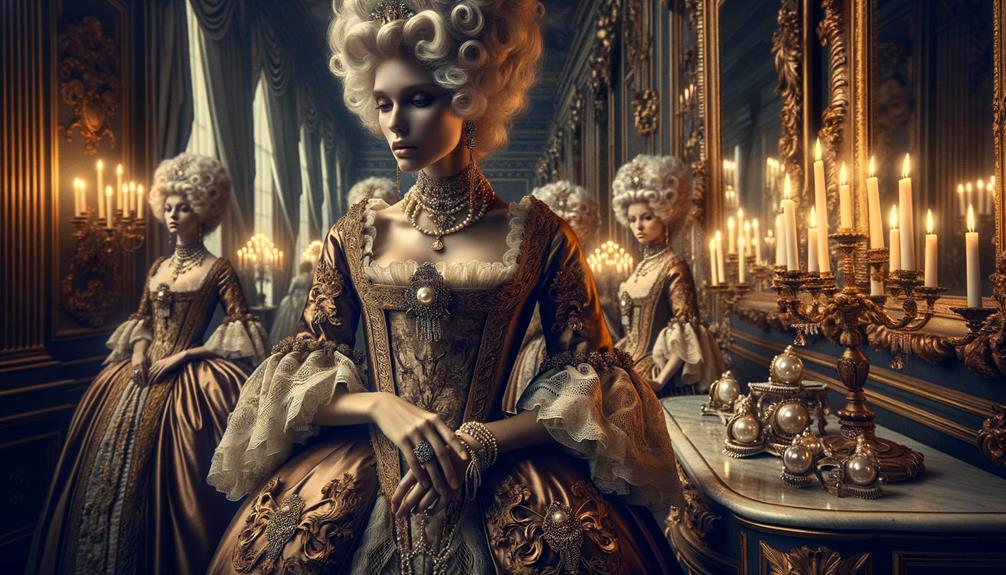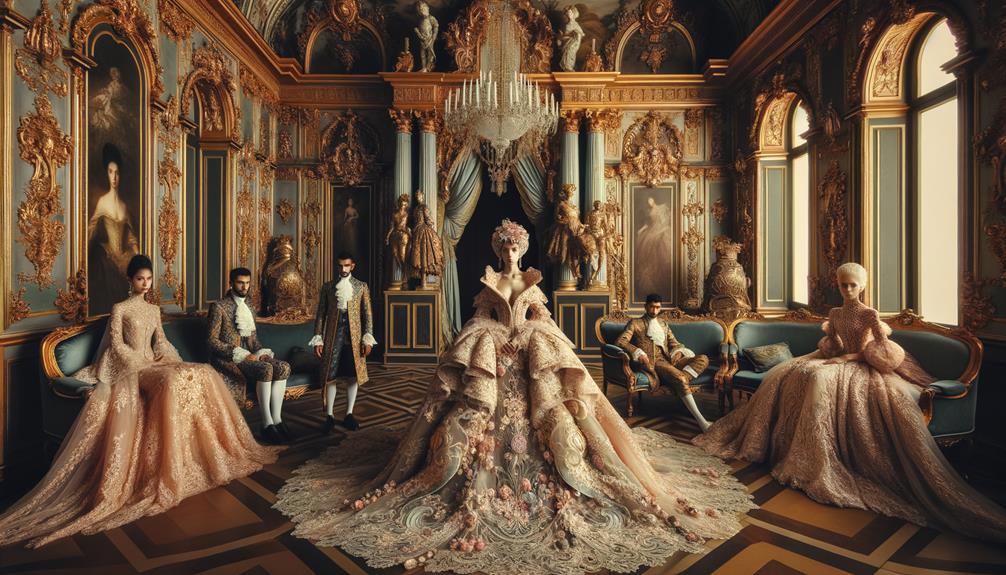Imagining the soft glow of candlelight on pastel silks, I find myself drawn to the gentleness of Rococo fashion. This period, emerging in the 1730s, stood in contrast to the opulence of the Baroque era. There's an understated elegance in the flowing silhouettes and intricate patterns that feels almost whimsical. Observing the softened corsets and floral accents, I can't help but wonder how these style choices reflected the shifting societal norms of the time. What did this embrace of a more feminine approach reveal about the desires and lifestyles of the French aristocracy?
Origins of Rococo Fashion
Rococo fashion emerged in the 1730s, a gentle shift away from the ornate grandeur of the Baroque era. It embraced a softer, more feminine aesthetic, led by the French aristocracy seeking a respite from the structured elegance of the past.
Under the influence of King Louis XV and his mistress, Madame de Pompadour, the Rococo style flourished. Madame de Pompadour herself embodied this new look, championing pastel colors and intricate patterns that infused a sense of delicate charm into fashion. The decorative arts followed suit, mirroring this refined sensibility.
In men's fashion, Rococo retained many Baroque elements like the French suit and ubiquitous wigs, but the overall effect was less rigid and more fluid. Women's fashion, however, saw a significant shift. Gone were the stiff, structured silhouettes, replaced by looser, more flowing garments like the robe volante and robe à la française. These designs allowed for greater movement and a softer, more natural grace.
The Rococo style was not just a change in fashion; it reflected a society craving elegance and innovation.
Key Characteristics
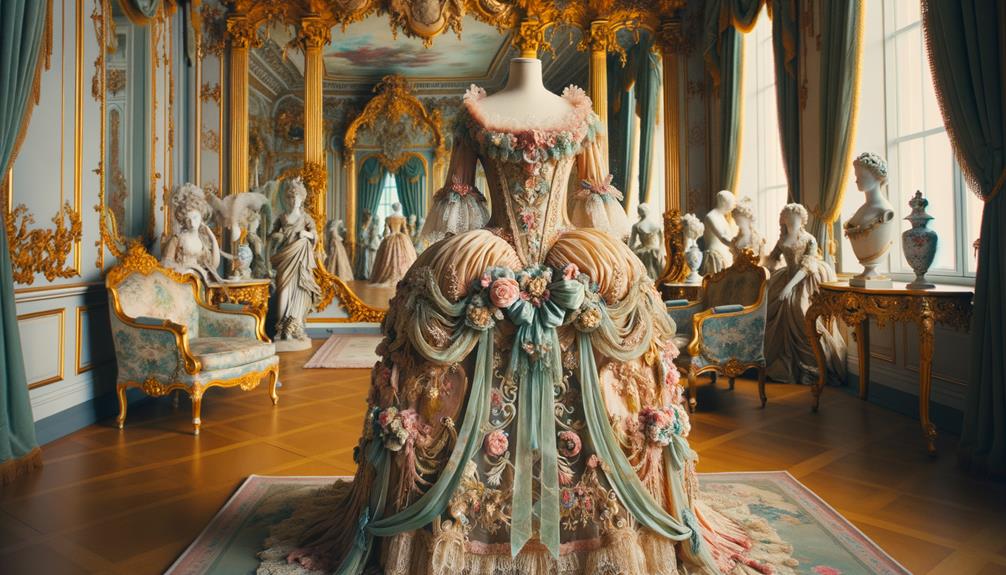
As Rococo fashion evolved from its Baroque roots, distinct characteristics emerged – a focus on softness, playfulness, and intricate detail. The shift was evident in the pastel colors that dominated the palette, with soft pinks, light blues, and gentle greens replacing the darker, more somber shades of the past. This new French style flourished under the influence of King Louis XV's court, where aristocratic women embraced the change.
Intricate patterns and delicate, flowing silhouettes became hallmarks of the Rococo era. Dresses like the robe volante and robe à la française allowed for a looser, more relaxed fit, moving away from the rigid structure that had defined previous eras. The subject matter in fashion echoed a life of leisure and pleasure, reflecting the luxurious lifestyles led by the aristocracy.
Menswear, while retaining elements like the jabot collar and tricorn hat, adopted a more playful, embellished aesthetic. Accessories and elaborate hairstyles, inspired by icons like Madame de Pompadour, became essential. These elements combined to create a fashion landscape that was both intricate and whimsical, capturing the spirit of Rococo.
Women's Attire
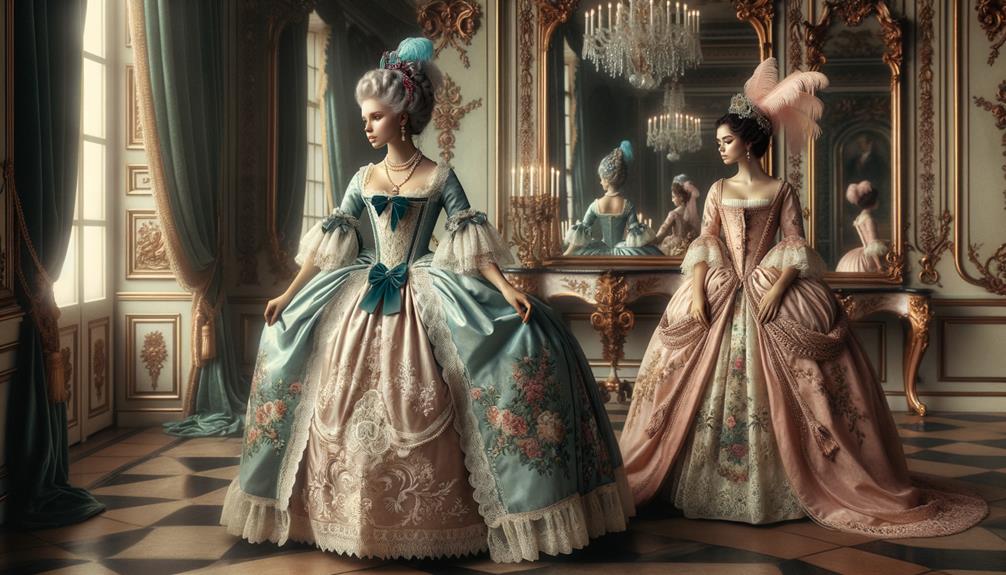
During the Rococo period, women's fashion evolved towards a more relaxed and ornate style, exemplified by the robe volante and robe à la française. These garments offered a greater sense of freedom and fluidity compared to previous eras. The robe volante, with its loose-fitting design and large pleats cascading from shoulders to hem, felt like an elegant embrace. In contrast, the robe à la française cinched the waist at the front, yet allowed the back to flow freely, creating a balanced silhouette of restraint and release.
Corsets still shaped the body, but the formality of earlier periods softened. Panniers emerged, adding volume to the sides of skirts, enhancing the overall silhouette. Women adorned themselves in taffeta silks, often in pastel hues that whispered of subtlety and grace. Floral accents and fur trimmings further embellished these creations, adding layers of texture and opulence.
These shifts reflect a desire for both comfort and grandeur. The Rococo style, with its intricate details and emphasis on softer elegance, represents a nuanced approach to fashion that values both aesthetics and ease.
Men's Attire
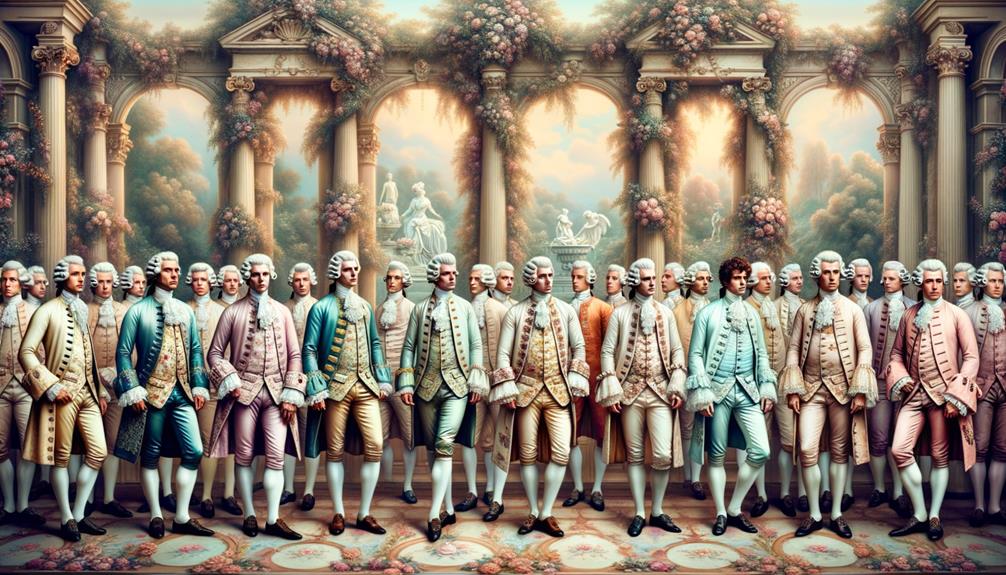
Men's fashion during the Rococo period reflected a shift towards a more relaxed yet intricate style, emphasizing leisure and refined embellishments. The Baroque period's grandeur gave way to a more delicate elegance, with King Louis XIV's influence gradually diminishing as Madame Pompadour's vision took center stage.
Pastel colors dominated men's wardrobes, a departure from the darker tones of the past. Waistcoats and coats were often matched, adorned with shoulder bows. The French suit became a staple, its design highlighting symmetry and grace. Trousers grew to knee-length, extending over stockings, while overcoats flared out, serving both practical and decorative purposes.
This Rococo style celebrated the leisurely lifestyle of the upper class. Men's fashion was not merely about clothing; it was a statement of elegance and ease. Shirts, underpants, stockings, and leather shoes remained, but the jabot collars and tricorn hats added a touch of playfulness. The pursuit of pleasure and spontaneity underscored every aspect of their attire, contrasting sharply with the formality of the Baroque period.
In essence, Rococo men's fashion embraced a softer, more feminine approach, mirroring the era's broader cultural shifts.
Influence on Society
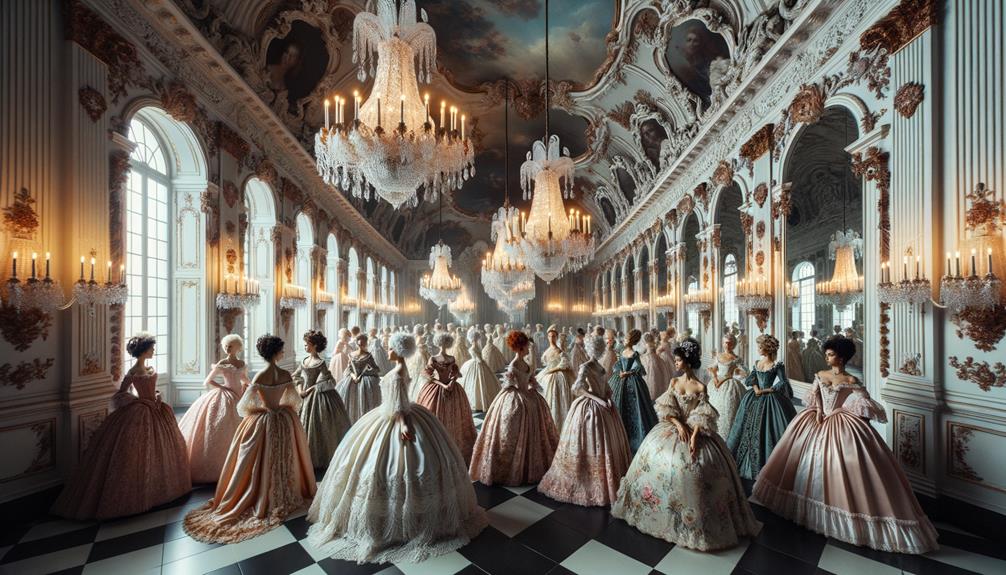
Rococo fashion didn't just shape the wardrobes of the elite; it also highlighted the divide between the aristocracy and the common people. The Rococo period, known for its pastel colors and elaborate designs, reflected the indulgent lifestyles of the French court. Madame Pompadour, the mistress of King Louis XV, exemplified this opulence with her preference for soft pastel shades and intricate designs, setting the tone for the era.
Observing society through this lens, three key images come to mind:
- Aristocratic salons filled with women in flowing gowns, their hair styled in towering creations.
- The contrast of commoners in simple, practical attire, casting a critical eye on the ostentatious displays of wealth.
- A young Marie Antoinette in her early days, embracing the Rococo style before it became a symbol of excess.
The Rococo style emphasized luxury and flirtation, reinforcing the social divide. The exaggerated hairstyles and elaborate costumes of the nobility stood in stark contrast to the modest clothing of the commoners. This disparity fueled resentment, setting the stage for broader societal upheavals. As the demand for practicality and democratic ideals grew, the decline of the Rococo style became a poignant chapter in fashion history.
Modern Interpretations
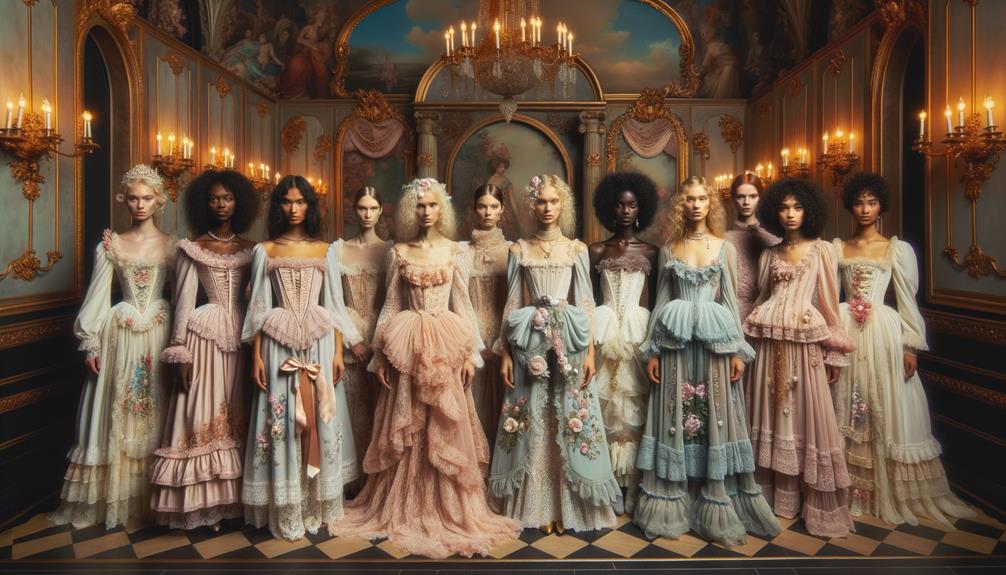
Modern fashion has found itself continually drawn to the playful elegance of Rococo, weaving its delicate aesthetics into contemporary designs. The pastel colors, sensual curves, and ornate embellishments echo an era long past, yet they feel oddly current. It's fascinating how the Rocaille elements, once symbols of aristocratic leisure, have been repurposed for the modern age.
Runway shows are brimming with elaborate hairstyles and lavish trimmings, reminiscent of Francois Boucher's paintings. The romanticized silhouettes evoke the fete galante scenes, capturing a sense of lightheartedness. Even in everyday fashion collections, floral prints and asymmetric necklines nod to the playful spirit of the 18th-century French aristocracy, a time just before the French Revolution changed everything.
Accessories like ornate jewelry and lace trim serve as subtle yet powerful reminders of Rococo's enduring charm. They allow us to infuse a touch of French elegance into our daily lives. This pursuit of pleasure and beauty is not just limited to fashion; it extends to interior design and even into the style of architecture, once celebrated under the Sun King. Modern interpretations of Rococo speak to our desire for innovation, rooted in timeless elegance.
Frequently Asked Questions
Is Rococo Style Feminine?
The Rococo style is often associated with a feminine aesthetic. Its soft, flowing lines, pastel colors, and delicate details reflect the tastes and fashions favored by aristocratic women during the 18th century. The ornate embellishments and elegant silhouettes convey a sense of leisure and luxury, aligning with the preferences of the upper-class female clientele. The Rococo style's emphasis on grace, beauty, and ornamentation has been widely interpreted as embodying a feminine sensibility within the art and design of the period.
How Did the Rococo Style Affect Fashion?
The Rococo style had a notable influence on fashion. It brought about the use of light, airy fabrics, delicate pastel colors, and intricate details. This shift in style moved fashion towards a greater emphasis on elegance and refinement, rather than grandeur. The Rococo aesthetic seemed to encourage more personal expression and individuality in clothing choices. Overall, it marked a transition towards a more graceful and delicate fashion sensibility.
What Is the Main Idea of the Rococo Style?
The Rococo style is all about elegance and lightness. It's a shift towards intricate, playful designs with pastel colors. The art and fashion of this period have a more personal, intimate feel compared to previous styles. The Rococo aesthetic moves away from the grandeur and formality of earlier periods, embracing a softer, more whimsical approach.
Was Rococo Art Influenced by Female Patrons?
Rococo art was profoundly shaped by the tastes and sensibilities of female patrons. The delicate colors, the leisurely themes – these elements were a reflection of the refined preferences of the women who commissioned and supported this artistic movement. Rococo flourished under the guidance and patronage of these influential female figures, whose aesthetic inclinations molded the very essence of the style.
Conclusion
Reflecting on Rococo fashion, I recall a painting of Madame de Pompadour. Her dress, soft and floral, seemed to float gracefully. It wasn't just fabric, but a statement – a departure from the rigid past. This more feminine approach didn't just adorn bodies; it liberated spirits. Today, in moments of quiet elegance, I see echoes of that era, reminding us that sometimes, gentleness can be the boldest form of expression.



